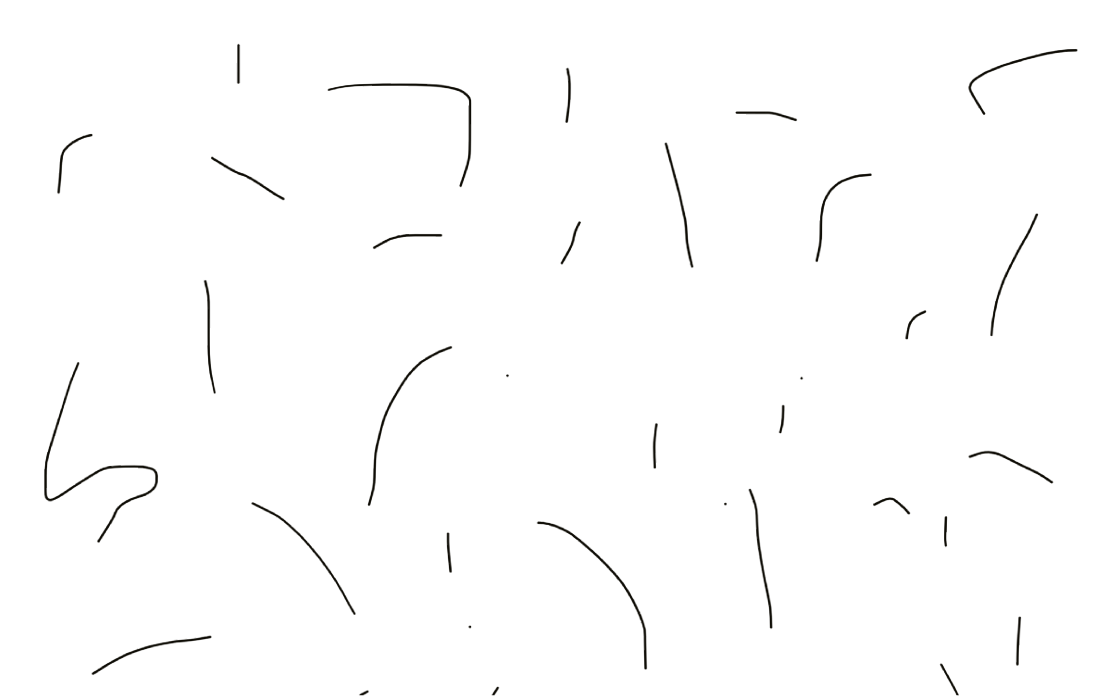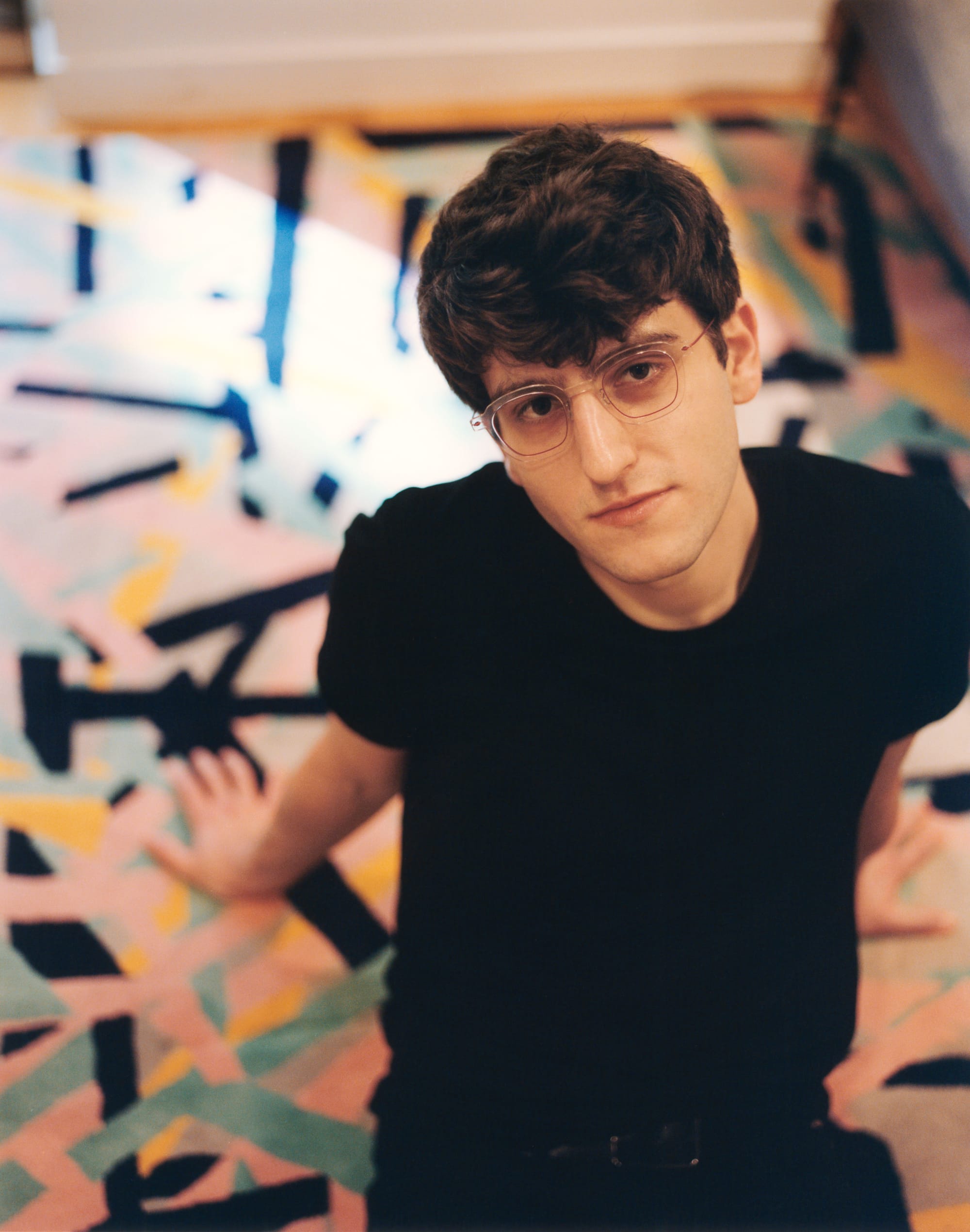Last month I had the privilege of publishing the second chapter of Nat Baldwin's new book Antithesis on Which Sinfonia, which is connected to a dual album release on Tripticks Tapes. Today we turn to another composer whose writing is a personal extension, poetic expansion, and scholarly exploration of their music – NYC-based Gideon Broshy, whose debut album Nest was released on New Amsterdam Records on 9/26. Broshy created this interactive site weaving together his music and text fragments from the essay for you to experience "as an environment inviting distributed, non-linear listening and play" during your reading.
– Anna Heflin

The everyday is charged with angularities in experience.
A sensibility snaps into place. Certainty splits into loose tendrils and deliquesces into a blur. Sitting on the couch, the stochastic mind on a random walk .. . impressions imbricate like petals . .. things slip in and out with vaporous subtlety or cataclysmic force.
Selves like bubbles in coruscating foam, contiguous but not continuous. An oblique encounter on a street, a loaded glance .. . a failure to see an other. In the contingent and improvisatory do-si-do of relation, dyads and clusters concatenate to chains of diaphanous association.
On the subway: a half-spied absurdity, the glint of a smirk shared across the car. Subjectivity, a fragile thread careening through a life, is caught up in a transitory entanglement, an assemblage of sweaty bodies with the blush of something or nothing. Then the intimate morass disperses, threads unspool, and eventually it's history.
I’m a composer and pianist working at the intersection of improvisation, synthesis, and MIDI. My debut album, Nest, traces the erratic contours of ordinary feeling, thought, and encounter, attending to the intensities and banalities at that strange and prolific seam between self and world — where people meet the social in a tangle of connections. It unfolds as a free play of improvised shape, gathering harpsichords, celestas, synths, pianos, dulcimers, drums, and clarinets into bright, angular assemblages.
This work provoked diverse speculations. It asks how the shape of experience might relate to musical shape, to angular gesture and rhizomatic texture — and how music composition might relate to the dynamic composition of social worlds and social subjects.
The philosopher Peter Sloterdijk figures the self as a bubble: separated from but bound to other bubbles by thin, fragile walls, mutually isolated and interdependent.[1] Interiority and relation are caught in a paradox — people are cognitively and epistemically insulated from each other, but ineluctably entangled.
Life feels angular, at the odd juncture of self and world. Feelings, thoughts, and encounters come at you obliquely and erratically, “picking up density and texture as they move through bodies, dreams, dramas,” as the anthropologist Kathleen Stewart observes.[2]
Something hits, kicking up a hazy particulate. You get snagged on the fishhook of an anxious thought and it diffuses into an amoebic malaise. Or someone says something nice, or loves you, and a pink bloomspace surges into the thick interstice. Stewart calls these “ordinary affects,” the “varied, surging capacities to affect and to be affected that give everyday life the quality of a continual motion of relations, scenes, contingencies, and emergences.” They are acute impulses and sensations, expectations and daydreams, forms of contagion and compulsion. “Something throws itself together in a moment as an event and a sensation.”[3]
The positions of objects or bodies shift in a room, and a something opens up. You’re just there .. . chewing vacuously . .. attention swerves. Time pools and collects in cracks. Tension is a sedimented heaviness in the arm or tightening of the sternum. A patterned languor sets in. A bee stings, a snowflake alights on an eyelash. You drool a little bit. Slipstream of consciousness as a bandwidth. The subject as a pincushion, nexus of little pressures. A mood is a blanket .. . you float through it . .. or you don’t.
A clarinet skidding across a faceted surface .. . . the way a melodic leap cuts.
Sometimes experience is like stumbling through jaggedly arrayed tableaus. Henri Lefebvre, the sociologist of everyday life, calls these discontinuities social “arrhythmias,” inscribed on stretchy, viscous time.[4] Charting “time’s cascades within us,” Gaston Bachelard observes that “time does not flow. It springs up.”[5][6]

It's like getting swept up in the crook of a florid gesture. Computerized kalimbas twitch like scissor wings in moments of anxious preparedness.
Maybe you’re queer, and things feel particularly not straight. For Sarah Ahmed, orientation, sexual or otherwise, is the question of “how it is that we come to find our way in a world that acquires new shapes, depending on which way we turn.”[7] Any number of circumstances, like queerness, can make things appear particularly slantwise. Tavia Nyong’o posits queerness as “angular sociality.”[8]
One’s lifeworld is cobbled together as experiences, relations, objects, memories, and dreams accrue, glaciate. Life is a chain of time-space paths. Peripersonal space — the volume of space within one’s reach — is a mobile force field from which you experience things. You’re always at a unique locus in your biography.
You navigate the flow of situations. Michel Serres: Life “proceeds more like the flight of a wasp than along a line.”[9] The door handle doesn’t quite agree with your hand. Your laptop freezes or you break a glass or you trip, out of step with yourself. Sometimes you’re orthogonal to the world, sputtering through little frictions, but sometimes there’s the seamless habitus of credit cards, getting the Nespresso going while you pick out socks, a fishmonger slicing tuna with finesse and panache.
There’s a dermal immediacy on the razor’s edge of a taut string, or in the liquid gleam of a dream-stunned synth. Palpitations translated into billowing breath, drawing past a trembling reed. Pulse suspended in solution; repeated notes as a nervous tic.

The world is variously patterned according to your position in it. Conditions — historical, geographic, social, economic, political — make it possible to do, think, and feel certain things. For Raymond Williams, contingent historical configurations produce unique “structures of feeling.” They are “social experiences in solution,” not yet precipitated into precise articulation: a murkiness in the uneasy pragmatics of a distended phone call.[10]
You wanted to impress someone and think you’ve said the wrong thing. Biking home, nebulous doubt condenses into a residue. There is an ‘I’ you consult. Minute traumas and pleasures inflect each other and bleed together. There are four identical unthinking days and then one that perks up. There’s a lot of repetition but sometimes there are fulcra along which things really change — breaches in the self-evident.
People get together for dinner, or are stuck in an elevator, and put their faces to work. Warmth swells in the presence and silence of friendship. A group chat tightens the space of relations. In an ecology of paths and exchanges, intersubjectivity is produced in microsituational rituals of energetic and rhythmic alignment.[11] Bodies sync up. In the flesh of any interactional scene, intensities dart and diffract like fireflies, ideational rays cross-hatch — an assemblage, or composition, in material, semiotic, and affective elements.
Keyboards winking in prismatic constellations, points and vectors that snap into place like Rubik’s cubes. Celeste and harpsichord curling around each other like spindle fibers. A pair of pianos babbling and burbling in estranged juxtaposition, gazes and temporalities out of joint. A swooping figure that triggers a ricochet shot across a dulcimer.

We routinely circumvent the strangeness of other minds. Language is a scaffolding for the shared intelligibility of the world. Attitudes and norms structure understanding and action, just as we produce them in mundane practices, habits, performances, and conversations. We’re suspended in patchy webs of subtler signification and suggestion, patterned with contemporary myths, totems, codes, and simulacra that suffuse our symbolic imaginations and hold us together.
We piece together a picture of a shared reality in microsocial fragments. Looking up at a sky we tacitly agree is blue, we recognize and affirm each other as perceiving subjects in a common world. We discuss politics, presupposing and reconstructing shared concepts like “government” and “democracy.”[12] Watching reality TV on the couch, giggly schadenfreude transits between us, affective resonance hardening into recognition, identity, solidarity. Practices and discourses continually produce pockets of common ground. Holding in a fart constructs the fart as taboo. A sort of parallax measurement takes place by which we triangulate mutual understanding and feeling — or don’t.

Subjectivity proceeds as a continuous enrichment and complication of our sense of the world: a million liquid interpretive acts and affective pricks are sedimented into semi-firm notions of how things are and what matters. Social life takes place in an ecosystem of things people singularly think and feel — a quivering flock of dovetails — sometimes converging and often diverging.[13] Interaction entails an implicit movement of faith: in the commensurability of my experienced world and yours.
Sometimes we’re on totally different wavelengths. I can’t read your face .. . you don’t really hear me . . .. is something wrong ... . . Roland Barthes: “Like a bad concert hall, affective space contains dead spots where the sound fails to circulate.”[14] I can’t know what it’s like to be you.
A day unfurls as a string of these crinkles and protuberances in experience. They shimmer, they’re patchy, they smear. And they have shape, rhythm, force. Buoyancy. If there is a phenomenological impulse in Nest, it’s to trace these immanent shapes and surfaces of the everyday. To sketch or map their routes and connections. A sharp breath, an empty pause, a dragging undertow, a disjuncture in time or pitch or space. To play with shapes, to get at the shape of things. Walt Whitman: “The shapes arise! Shapes of doors giving many exits and entrances.”[15]

Subjectivity meets the dense web of sociality in a charged, reflexive blur. In Sloterdijk’s intellectual imagery, bubbles concatenate to social “foams.”[16] Sociologists call them nodes and networks.
The structure of relations is a topology of ties undergirding book club, the playground, the biotechnology industry, Instagram, and your diasporic family. Stories seep through networks and reconfigure them, mutating in the process.[17] Angular moments and prismatic bundles accrete to complex constellations. Shifting patterns of association and communication spin out patchy provinces of meaning and feeling. Private sentiments enter public circulation and flow aleatorically; “affects are projectiles.”[18] Crowds are “rhythmic,” they “love density,” they vibrate and effervesce.[19]
Against prefabricated, inert conceptions of social structure, Gilles Deleuze posits sociality as a pure multiplicity — a heterogeneous tissue of connections, movements, and becomings, intensities and densities, through which the social is actively assembled and reassembled. Material, discursive, and affective pressures splatter pointillistically. Chains of little circumstances are erratic lines of flight.
Harpsichord threads coiling into a dense, kinetic lacework of relation. A dappled field of pianos multiplying like lily pads.

For Serres, the disorderly social world is a bubbling swirl, an entropic buzz, a generalized “noise.” Multiplicity is a “sheeting cascade” out of which phenomena — a phrase, a pang, a self — sometimes fall.[20] Objects and meanings congeal; sociocultural forms emerge, with more or less durability. He recalls Lucretius, who tells us that complex structures arise because atoms angle off course like a car changing lanes; minute swerves lead to unpredictable collisions and pileups. Serres describes time as a “crumpled handkerchief” to capture its recursions and false starts, its jitters and amnesias, its tics and folds.[21]
This dynamic complexity enfolds us in a dialectic of unity and multiplicity by which the self and the social are mutually constituted. Agency is distributed across knotty assemblages, collapsing the fabulation of a monadic, stable subject acting on the world. Deleuze writes, “the self is only a threshold, a door, a becoming between two multiplicities.”[22]
In Nest, oblique musical objects and strands collide, intertwine, and aggregate rhizomatically to form heterogeneous textures and fields, swarms and scenes, attuned to this dialectic of one and many. Inscribed with the inscrutable intricacy of an emergent and unstable present, my work originates in a curiosity about what springs up, and attention to the shape and mess of things. To compose is to assemble, here with shards and flecks, in bursts and smears, thrown together into emergent forms. It’s feeling out curves and bends and following them into their entanglements and immersions, the indeterminate energetics that compose kaleidoscopic worlds and selves.
Arising from improvisation, synthesis, and MIDI, Nest was assembled in fragments on the elastic canvas of free time. Thrown into sonic multiplicity, I imagined the record as a sort of nomadic cartography of the multiple, one that disorients as much as it orientates.[23] In which immanent parts and wholes are pressed together in thick circuits, and sonic multitudes never transcend the dense differentiation of their elements. In which local and global, granular and atmospheric, precise and panoramic, singular and plural are reciprocally formed, as gestures and patterns, habits and tics circulate. Anthropologists Marina Peterson and Jesse Shipley write, “Texture is the shifting edge between categories where terrains blend, a process of betweenness … the ground from which an object emerges, coming into being in that process .. . the stickiness that puts pressure on a rational subject."[24]
David Foster Wallace lingers on “the difference between the size and speed of everything that flashes through you and the tiny inadequate bit of it all you can ever let anyone know,” like an enormous full room, the smallest bit of which is squeezed through a tiny keyhole. “We are all trying to see each other through these tiny keyholes.”[25] We’re pressed together into a densely reticulated multiplicity, but you’re opaque to me. There’s an odd loneliness in this intimate isolation, this coincidence of abundant proximity and distance. Stewart and Lauren Berlant: “Someone is somewhere but no one takes them personally.”[26] I don’t know what it’s like to be you. Claudia Rankine: “We will always fail each other in some way or another.”[27] Each improvised life is a singularity elusive to others — pure difference, pure immanence — with extension backwards and forwards in time and space, sometimes caught at an indivisible moment of encounter.
Doors do open, imperfectly. Bubbles do burst or merge. Euphoric irruptions and effervescent intimacies happen. And we can imagine subjectivity and intersubjectivity without relying on the image of a solipsistic, bounded psychic interior, requiring transit over an intractable gap. The midcentury phenomenological philosopher Maurice Merleau-Ponty describes the relationship between perceiving self, world, and other not as a juncture but as a chiasm, an intertwining. When you touch your left hand with your right you constitute yourself as both subject, touching, and object, touched: both an ‘I’ and a thing in the world. Something similar happens in a handshake — in intercorporeal exchange you are, reversibly, both selves and others. The distance between people “is not an obstacle between them, it is their means of communication.” Intersubjectivity, and our immersion in a shared, plural world of people and things more generally, is a sort of “spontaneous configuration of parts,” in which each part is singular, but defined only in its imbrication with other singularities. Subjects and objects are interlocking figures composing a ground of pure difference, like pieces of a liquid puzzle, threads of a fabric, tendons in a “universal flesh,” bubbles and foam. The multiple world is “a texture that returns to itself.”[28]
Emmanuel Levinas embraces the intrinsic incommunicability of the subjective as fundamental. Subjectivity is composed intersubjectively: an ‘I’ is formed when one is called to, affected, seen, touched by a strange and unknowable other. It is the radical irreducibility and incommensurability of my experience and yours, in our alterity, that structures relation and the self. The absence or distance of the other — what you did before we met on the street, where you’re heading, what you masturbate to, the shape of your worry, the haptics of bangs on your forehead — is exactly their singular presence or proximity as other.[29]
For Jean-Luc Nancy, self, other, and world collapse into a social ontology of “being-with,” for which the essential condition of being is relation. I am assembled by a multiplicity of yous, and the interstices that separate but constitute us. Sociality is simultaneously singular and plural; experience is always already interstitial. At the heart of every relation is this spacing, this distance, this difference. “From one singular to another, there is contiguity but not continuity .. . the law of touching is separation.” Subjectivity and intersubjectivity emerge through contingent encounters in which we never quite reach each other, from which we are perpetually receding. “Everything, then, passes between us.”
The self is a point of accumulation, a continual emergence from the “general differentiation of the everyday, its constantly renewed rupture, its intimate discord, its polymorphy and polyphony .. . the variously multiplied intimacy of the world.” Social life gives us momentary now-points of access to obscure subjectivities, with their singular microhistories and contingent futures, like “the interlacing of strands whose extremities remain separate even at the very center of the knot,” passing discreetly in synchronic diachrony.[30]
An instant is an edge. Entanglement is an improvisation. Multiplicity is potentiality, capaciousness . .. . . “noise is the opening”[31] . . . . a record is like a handshake. Time stretches when people touch.
Gideon Broshy is a composer, pianist, and producer from New York City. He builds clouds and swarms from sharp figures, using improvisation, synthesis, and MIDI. His music attends to the strange and prolific seam between self and world — where people meet the social in a tangle of connections.
As a composer and producer, he’s worked with artists like Sō Percussion, Roomful of Teeth, Matt Evans, and Wendy Eisenberg. As a pianist, he’s performed on NPR and at Carnegie Hall. His interdisciplinary work includes projects for dance, theater, film, and installation, at venues like the Yale University Art Gallery and with directors Kali Davis and Jaime Sunwoo. Work in 2025 includes Nest, his debut album with New Amsterdam Records; a residency at Millay Arts; and an experimental rock project.
He studied music and sociology at Yale, the London School of Economics, and Juilliard.

[1] Peter Sloterdijk, Spheres, Vol. 1: Bubbles, trans. Wieland Hoban (Semiotext(e), 2011).
[2] Kathleen Stewart, Ordinary Affects (Duke University Press, 2007), 3.
[3] Stewart, 1-2.
[4] Henri Lefebvre, Rhythmanalysis: Space, Time, and Everyday Life, trans. Gerald Moore & Stewart Elden
(Bloomsbury Academic, 2013 [1992]), 25.
[5] Gaston Bachelard, Dialectic of Duration, trans. Mary McAllester Jones (Rowman & Littlefield, 2016
[1936]), 81.
[6] Gaston Bachelard, Intuition of the Instant, (Gonthier, 1966 [1932]), 106.
[7] Sarah Ahmed, Queer Phenomenology: Orientations, Objects, Others (Duke University Press, 2006), 1.
[8] Tavia Nyong’o, Afro-Fabulations: The Queer Drama of Black Life (NYU Press, 2018).
[9] Michel Serres and Bruno Latour, Conversations: on Science, Culture, and Time (University of Michigan Press, 1995), 65.
[10] Raymond Williams, Marxism and Literature (Oxford University Press, 1977), 133.
[11] Randall Collins, Interaction Ritual Chains (Princeton University Press, 2004).
[12] Harold Garfinkel, Studies in Ethnomethodology (Prentice-Hall, 1967).
[13] Dan Sperber, Explaining Culture: A Naturalistic Approach (Blackwell, 1996).
[14] Roland Barthes, A Lover’s Discourse: Fragments, trans. Richard Howard (Hill and Wang, 1978), 167.
[15] Walt Whitman, “Song of the Broad-Axe,” in Leaves of Grass and Other Writings, ed. Michael Moon (W.W. Norton & Company, 2002 [1856]), 155.
[16] Peter Sloterdijk, Spheres, Vol. 3: Foams, trans. Wieland Hoban (Semiotext(e), 2016).
[17] Harrison C. White, Identity and Control: A Structural Theory of Social Action (Princeton University Press, 1992), 65-69.
[18] Gilles Deleuze and Félix Guattari, A Thousand Plateaus: Capitalism and Schizophrenia, trans. Brian Massumi (University of Minnesota Press, 1987), 400.
[19] Elias Canetti, Crowds and Power, trans. Carol Stewart (Viking Press, 1962), 29.
[20] Michel Serres, Genesis, transl. Geneviève James and James Nielson (University of Michigan Press, 1995), 18.
[21] Serres & Latour, 60.
[22] Deleuze & Guattari, 249.
[23] For a perspective on the critical potential of artmaking that is map-like, see Fredric Jameson’s notion of “cognitive mapping,” in Fredric Jameson, Postmodernism, or, The Cultural Logic of Late Capitalism (Duke
University Press, 1991).
[24] Marina Peterson and Jesse Weaver Shipley, “Texture of Nothing,” in The Trouble With Art, ed. Roger Sansi and Jonas Tinius (Routledge, 2024), 191.
[25] David Foster Wallace, “Good Old Neon,” in Oblivion: Stories (Little, Brown & Co., 2004), 178.
[26] Kathleen Stewart and Lauren Berlant, “Couplets,” Women & Performance: A Journal of Feminist Theory 29, no. 3 (2019): 199-210.
[27] Smitha Khorana, “Interview with Poet Claudia Rankine: ‘Racism Works Purely on Perception’ in America,” The Guardian, December 27, 2014.
[28] Maurice Merleau-Ponty, The Visible and the Invisible, transl. Alphonso Lingis (Northwestern University Press, 1968).
[29] Emmanuel Levinas, Otherwise than Being, or Beyond Essence, transl. Alphonso Lingis (Duquesne University Press, 1981).
[30] Jean-Luc Nancy, Being Singular Plural,trans. Robert D. Richardson and Anne E. O’Byrne (Stanford
University Press, 2000).
[31] Serres, 22.


